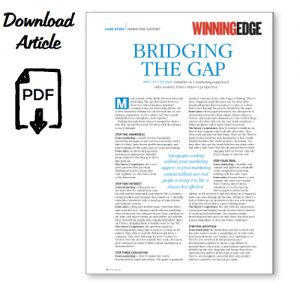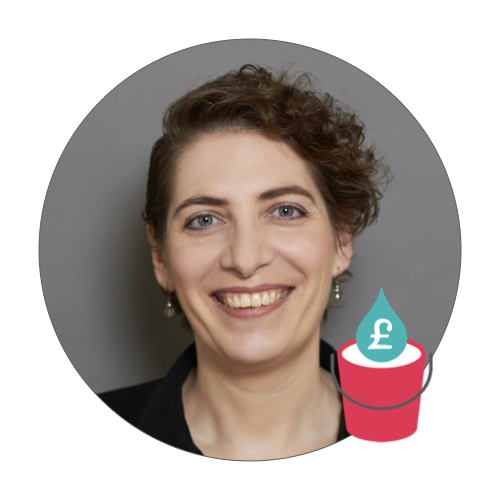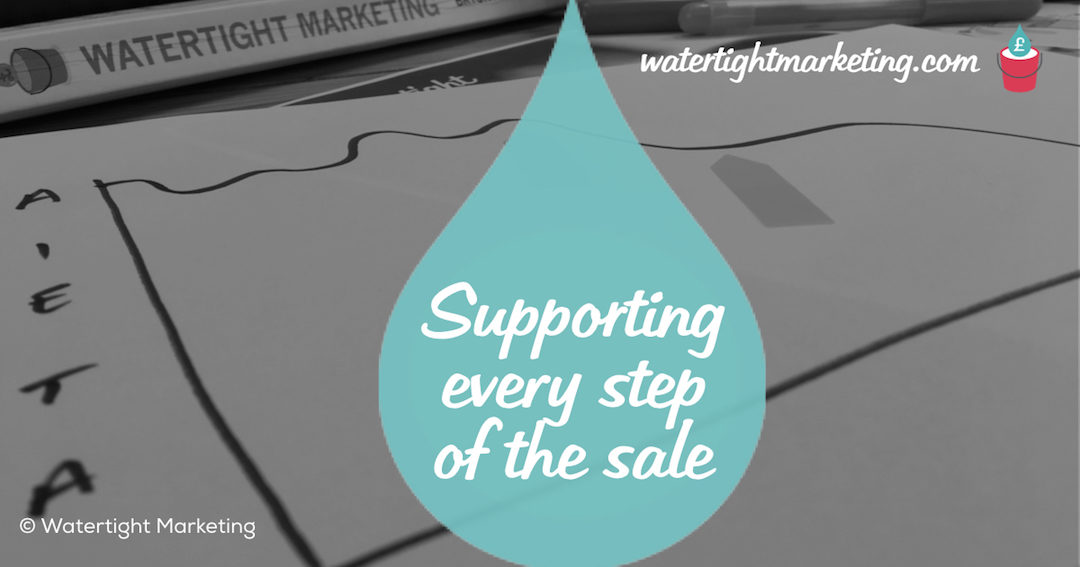Much is made of the divide between sales and marketing. It’s certainly makes for interesting debate, but it does absolutely nothing for your bottom line or your business reputation. So, let’s spell it out. How exactly should these two disciplines work together?
Walking the path from a buyer’s perspective shows how this can and does work for those with the patience to see it through.
Step one: Awareness
From marketing: A steady stream of genuinely interesting messages to put out in social media, with a link to a blog. Some decent profile photography, and some training for the sales team on social networking.
From sales: An interesting question posted in an appropriate LinkedIn group related to the blog post that’s just gone up.
The buyer’s experience: They see a great question that gets them thinking posted in a group they visit regularly. So, they take a look at the discussion.
Step two: Interest
From marketing: A blog post on a hot issue that the salesperson came up with, and the marketing team helped edit to include a strong headline and an image that stands out. A monthly subscriber newsletter with a round-up and exclusive content.
From sales: A blog post in their name, with their photo and social IDs on it. Having worked with the marketing team on the post, the salesperson now feels confident on the topic and enjoys having an open debate in LinkedIn. She researches the people who respond and follows them on Twitter, dropping them a friendly tweet to say Hi.
The buyer’s experience: The question sparks an interesting debate and a link is posted to a blog on the subject. They click it, read the full post and leave a comment. They start following the post’s author on Twitter. Over the next few months they read a few more posts and pass on some of their content, and sign-up to their newsletter.
Step three: Evaluation
From marketing: A ‘How-to’ guide that can be downloaded by email subscribers. The guide is genuinely useful to someone in the early stages of buying. There’s also a triggered email that goes out two days after downloading that directs people to a video of a client that’s been through the process detailed in the paper.
From sales: The salesperson is alerted when people download and researches them online, follows them on Twitter, reads and comments on a few of their blogs. Anyone who then clicks on the case study email gets a follow-up phone call to invite them to an event.
The buyer’s experience: They’ve started to build up an idea of this company and really like their style. They often read and pass on their blogs. They see the ‘How-to’ guide in the newsletter and download it. It has a really helpful checklist that they print out and stick up above their desk. Two days later, they get the email with the case study video and take a look. Later that day the person they’ve been engaging with on Twitter calls and they’re happy to take the call.
Step four: Trial
From marketing: Marketing work with the sales team to design a monthly web seminar and quarterly roundtable event.
From sales: Because there’s a web seminar that runs every month, there’s always one to invite somebody to. So, because the How-to guide is always in the sidebar on the newsletter and the follow-up is triggered, leads can come through all the time. Whenever there’s a lead to follow-up, an invitation to the next web seminar or in-person event makes a great starting point.
The buyer’s experience: The chat with the salesperson was natural and helpful, mostly because they’d chatted in social media beforehand. The seminar sounds interesting and they put it in their diary. But, their need is more immediate so they ask if they could meet for a coffee.
Step five: Adoption
From marketing: The marketing team has worked with the sales team to create a compelling set of sales tools, from presentations, case studies, facts and figures, etc. They’ve also reviewed all old proposals and presentations together to create a copy library of material that’s often used. A professional copywriter has polished this, diagrams and images have been smartened up and it’s all been given some real style. They’ve also designed a powerful first step product, which is a paid-for two-day project audit.
From sales: There’s no pressure to do a big presentation at a first meeting. They take a pen, a notepad, and a tablet device. The meeting is mainly about getting the buyer to talk about their needs. Depending on where the conversation goes, the salesperson can navigate to the materials they need. If appropriate, the salesperson suggests the two-day audit. From the audit, they put together a full proposal, in which they use the compelling copy and examples that have been made available in the copy library.
The buyer’s experience: The meeting felt right. There was no hard sell and the examples they went through were totally relevant. The two-day audit price was well within their sign-off authority, so they went for it without needing to ask anyone else. From there, the proposal that was presented was spot on and the relationship felt good.
Step six: Loyalty
From marketing: The marketing team have made a stock of business books in the right tone and topic available. The client set-up process has also been thoroughly reviewed so that the invoicing emails, the control panel log-in, etc. is smooth and consistent. They’ve also set-up a triggered set of welcome emails that go out over the first three weeks. These contain helpful hints and tips and some exclusive content. Client hospitality is put on throughout the year.
From sales: Salespeople put a book they think the client will enjoy in the post with a personalised thank you and Welcome Pack. They also keep in touch on Twitter and connect on LinkedIn. They tag people in the CRM according to their interests, e.g. Golf, to make sure they’re invited to the right hospitality events.
The buyer’s experience: The book and Welcome Pack are a really nice touch. In fact, they tweet a public thank you to the company. The set-up all goes smoothly and the emails they receive over the first few weeks are genuinely helpful. Over the year, they attend a golf day and get to know the whole team a bit better and they’ve even referred a few other people their way.
 You will generate more profitable and more sustainable sales results if you get this one nailed. Salespeople working without great marketing support, or great marketing content without any real people to bring it to life, is always less effective than it could be. When you have both, you have what it takes get your business on an upward curve. It’s what I call Watertight Marketing.
You will generate more profitable and more sustainable sales results if you get this one nailed. Salespeople working without great marketing support, or great marketing content without any real people to bring it to life, is always less effective than it could be. When you have both, you have what it takes get your business on an upward curve. It’s what I call Watertight Marketing.
This article originally appeared in Winning Edge the membership magazine of the Institute of Sales and Marketing Management.
© Bryony Thomas – The Watertight Marketer

Bryony Thomas
Author & Founder, Watertight Marketing
Bryony Thomas is the creator of the multi-award winning Watertight Marketing methodology, captured in her best-selling book of the same name. She is one of the UK's foremost marketing thinkers, featured by the likes of Forbes, The Guardian, Business Insider and many more, and in-demand speaker for business conferences, in-house sales days and high-level Board strategy days.



Bryony, I have always maintained that the division between sales and marketing can create a serious loss of focus on how the buyer interacts with a company. It is so refreshing to read your article. I am a long way from having my “one man band” processes perfect in this, but keeping this process in mind is making a difference. Now where did I put my copy of “Watertight Marketing”?? I occasionally stray from the path when too busy on projects, but this has reminded me to get back and focus 🙂
Thanks Kate. I firmly believe the separation (either in one’s mind or structurally in a business) of these two inter-dependent activities always leads to a less enjoyable process for the buyer, and less profitable outcome for the business. And, you make a great point that in many small businesses, both are undertaken by one person. It’s essential to get the picture clear in our minds to make it work well for everyone… hence all the illustrations in that book you mention 😉
Diploma of Marketing
Whether you have one salesperson or 10, outfitting your front line with the right tools is critical to your company’s success. Production of collateral materials often falls to marketing staffs that design in a vacuum, without true insight into the day-to-day operational requirements–and just plain hands-on, grab-and-run nature–of salespeople. The result? Some recent studies suggest that as much as 80 percent of materials created by marketing staffs for the use of salespeople go unused, while salespeople often create their own less-than-stellar tools on the fly. Meanwhile, important branding and selling messages can fall by the wayside, and sales may decline or stagnate.